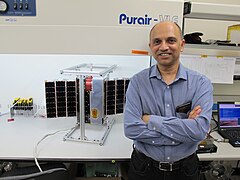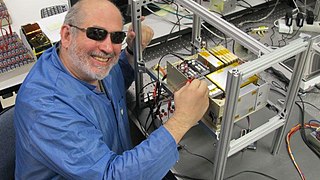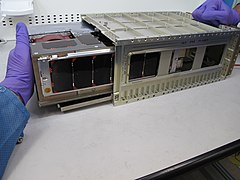CubeSat for Solar Particles (CuSP) was a low-cost 6U CubeSat to orbit the Sun to study the dynamic particles and magnetic fields.[2][3] The principal investigator for CuSP is Mihir Desai, at the Southwest Research Institute (SwRI) in San Antonio, Texas.[2] It was launched on the maiden flight of the Space Launch System (SLS), as a secondary payload of the Artemis 1 mission on 16 November 2022.[1][4]
Following deployment from the Artemis launch adaptor, contact with the spacecraft showed that it successfully stabilized and deployed its solar arrays, but contact was long after about an hour.[5]
Objective
Measuring space weather that can create a wide variety of effects at Earth, from interfering with radio communications to tripping up satellite electronics to creating electric currents in power grids, is of importance. To create a network of space weather stations would require many instruments scattered throughout space millions of miles apart, but the cost of such a system is prohibitive.[2] Though the CubeSats can only carry a few instruments, they are relatively inexpensive to launch because of their small mass and standardized design. Thus, CuSP also was intended as a test for creating a network of space science stations.[2]
The CuSP team
CuSP Spacecraft Team:[6]
Dr. Mihir Desai, PhD: Principal Investigator
Mike Epperly: Project Manager
Dr. Don George, PhD: Mission System Engineer
Chad Loeffler: Flight Software Engineer
Raymond Doty: Spacecraft Technician
Dr. Frederic Allegrini, PhD: SIS Instrument Lead
Dr. Neil Murphy, PhD: VHM Instrument Lead
Dr. Shrikanth Kanekal, PhD, MERiT Instrument Lead
Payload
This CubeSat carried three scientific instruments:[2][3]
- The Suprathermal Ion Spectrograph (SIS), is built by the Southwest Research Institute to detect and characterize low-energy solar energetic particles.
- Miniaturized Electron and Proton Telescope (MERiT), is built by the NASA's Goddard Space Flight Center and will return counts of high-energy solar energetic particles.
- Vector Helium Magnetometer (VHM), being built by NASA's Jet Propulsion Laboratory, will measure the strength and direction of magnetic fields.
- Propulsion
The satellite features a cold gas thruster system for propulsion, attitude control (orientation) and orbital maneuvering.[7]
Spacecraft bus
The spacecraft's bus consisted of:[6]
- SwRI Spacecraft Integrator: Design, Assembly, Integration and Test
- SwRI SATYR Command and Data Handling Unit
- SwRI Flight Software
- Clyde-Space AAC Electrical Power System
- BCR MPPT converters
- LiPo Batteries and
- Deployable and Fixed Solar Arrays
- VACCO MiPS Cold Gas Thruster
- Blue Canyon Technologies XACT ADCS with Integrated Thruster Control
- SwRI Spacecraft Structure Mechanical and Thermal (SMT)
- NASA JPL/SDL IRIS X-Band Deep Space Transponder
- NASA GSFC Mission Operations Center
- NASA Deep Space Network Ground Communication
Flight results
- After a successful launch of the SLS at 1:47 am EST on November 16 2022, The Orion/ICPS performed a Trans-Lunar Injection and separated.
- Shortly thereafter, CuSP was deployed from its launch canister in the ICPS.
- Twenty-three minutes after deployment, DSN received Open Loop Receiver (OLR) telemetry from CuSP indicated it had booted up, detumbled, deployed solar arrays, and assumed a SAFE, Sun-pointing, orientation.
- It was operating perfectly until...
- OLR monitoring of the radio signal indicated that the transmitter carrier signal vanished after transmitting for 1 hour and 15 minutes.
- No cause has been determined for this end of transmission.
- Multiple attempts to receive additional signals from the spacecraft failed through the end of 2022. No contact was made.
- The CuSP team fully investigated a sudden battery temperature increase and found it was a telemetry failure. This was verified by comparing redundant indications of several parameters. The redundant indications did not show the suspected excursion. This failure was proven to be the failure of a temperature monitor which saturated the ADC inputs of several signals, but not their redundant monitors fed to an independent ADC.
- The CuSP team fully investigated an anomalous high IRIS Radio temperature. JPL IRIS engineers traced it to a failure to update a scaling equation in the SMOC EGSE. Once the updated equation was applied, the temperature fell in line with all others.
- Plans were to make another attempt during an expected focal convergence, however, no further contact attempts were made to contact the spacecraft.
- Official end of mission was declared December 2023.
Gallery
-
CuSP is instrumented and placed in the Thermal Vacuum Chamber.
-
Dr. Mihir Desai, Principal Investigator, seen with CuSP
-
Dr. Don George, Mission Engineer, testing the Electrical Power System (EPS) on CuSP.
-
Dr. Gumby presenting the post deployment sequence of operations of CuSP to a NASA review panel.
-
CuSP weighs-in at a 'wet mass' of 10.2 kg, well within the 14 kg mass limit.
-
The 'Purple Hands' verify that CuSP fits into its dispenser. This dispenser pushes CuSP out of the launch vehicle.
-
The Principal Technician for CuSP, Raymond Doty, makes final 'Pack and Ship' preparations for CuSP.
See also
The 10 CubeSats flying in the Artemis 1 mission
- Near-Earth Asteroid Scout by NASA was a solar sail spacecraft that was planned to encounter a near-Earth asteroid (mission failure)
- BioSentinel is an astrobiology mission
- LunIR by Lockheed Martin Space
- Lunar IceCube, by the Morehead State University
- CubeSat for Solar Particles (CuSP)
- Lunar Polar Hydrogen Mapper (LunaH-Map), designed by the Arizona State University
- EQUULEUS, submitted by JAXA and the University of Tokyo
- OMOTENASHI, submitted by JAXA, was a lunar lander (mission failure)
- Cislunar Explorers, Cornell University, Ithaca, New York
- Earth Escape Explorer (CU-E3), University of Colorado Boulder
References
- ^ a b Roulette, Joey; Gorman, Steve (16 November 2022). "NASA's next-generation Artemis mission heads to moon on debut test flight". Reuters. Retrieved 16 November 2022.
- ^ a b c d e "Heliophysics CubeSat to Launch on NASAs SLS". NASA. 2 February 2016. Retrieved 9 March 2021.
 This article incorporates text from this source, which is in the public domain.
This article incorporates text from this source, which is in the public domain.
- ^ a b Messier, Doug (5 February 2016). "SwRI CubeSat to Explore Deep Space". Parabolic ARC. Retrieved 9 March 2021.
- ^ Harbaugh, Jennifer (23 July 2021). "Artemis I CubeSats will study the Moon, solar radiation". NASA. Retrieved 22 October 2021.
- ^ Interrante, Abbey (8 December 2022). "Artemis I Payload CuSP CubeSat Mission Update". NASA. Retrieved 26 May 2024.
- ^ a b George, Don (21 April 2016). "The CuSP interplanetary CubeSat mission" (PDF). California Polytechnic State University.
- ^ "CuSP Propulsion System". VACCO Industries. 11 August 2017. Retrieved 20 August 2022.









Recent Comments